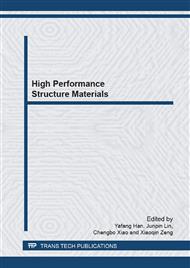[1]
Otsuka K, and Ren X. Physical metallurgy of Ti–Ni-based shape memory alloys. Progress in Materials Science2005, 50(5): 511-678.
DOI: 10.1016/j.pmatsci.2004.10.001
Google Scholar
[2]
Fu Y, Du H, Huang W, Zhang S, and Hu M. TiNi-based thin films in MEMS applications: a review. Sensors and Actuators A: Physical 2004, 112(2): 395-408.
DOI: 10.1016/j.sna.2004.02.019
Google Scholar
[3]
Neurohr A J and Dunand D C. Shape-memory NiTi with two-dimensional networks of micro-channels. Acta Biomaterialia 2011, 7(4): 1862-1872.
DOI: 10.1016/j.actbio.2010.11.038
Google Scholar
[4]
Neelakantan L, Swaminathan S, Spiegel M, Eggeler G and Hassel A W. Selective surface oxidation and nitridation of NiTi shape memory alloys by reduction annealing. Corrosion Science 2009, 51(3): 635-641.
DOI: 10.1016/j.corsci.2008.12.018
Google Scholar
[5]
Shabalovskaya S A. On the nature of the biocompatibility and on medical applications of NiTi shape memory and superelastic alloys. Bio-medical materials and engineering 1996, 6(4): 267-289.
DOI: 10.3233/bme-1996-6405
Google Scholar
[6]
Luan B, Cut N, LiuH, Zhao H, and Dou S. Low-temperature surface micro-encapsulation of Ti2Ni hydrogen-storage alloy powders. Journal of power sources 1994, 52(2): 295-299.
DOI: 10.1016/0378-7753(94)01960-6
Google Scholar
[7]
Dunlap R., O'Handley R., McHenry M, and Chatterjee R. Quasicrystal structure of rapidly solidified Ti-Ni-based alloys. physical Review B 1988, 37(14): 8484-8487.
DOI: 10.1103/physrevb.37.8484
Google Scholar
[8]
Asai S. Recent development and prospect of electromagnetic processing of materials. Science and Technology of Advanced Materials 2000, 1(4): 191-200.
DOI: 10.1016/s1468-6996(00)00016-4
Google Scholar
[9]
Gerald Tennyson P, Kumar P, Lakshmi H, PhanikumarG, and Dutta P. Experimental studies and phase field modeling of microstructure evolution during solidification with electromagnetic stirring. Transactions of Nonferrous Metals Society of China 2010, 20: 774-780.
DOI: 10.1016/s1003-6326(10)60580-8
Google Scholar
[10]
Li X, Z Ren. Alignment behavior of the primary Al3Ni phase in Al–Ni alloy under a high magnetic field. Journal of Crystal Growth 2008, 310(15): 3488-3497.
DOI: 10.1016/j.jcrysgro.2008.04.038
Google Scholar
[11]
Jin Y M. Domain microstructure evolution in magnetic shape memory alloys: Phase-field model and simulation. Acta Materialia 2009, 57(8): 2488-2495.
DOI: 10.1016/j.actamat.2009.02.003
Google Scholar
[12]
KZaidat. Control of melt convection by a travelling magnetic field during the directional solidification of Al-Ni alloys. C.R. Mecanique2007, 335: 330-335.
DOI: 10.1016/j.crme.2007.05.010
Google Scholar
[13]
Li C, Z Ren. Effect of magnetic fields on solid-melt phase transformation in pure bismuth. Materials Letters 2009, 63(2): 269-271.
DOI: 10.1016/j.matlet.2008.10.010
Google Scholar
[14]
Li X, Fautrelle Y and Ren Z. High-magnetic-field-induced solidification of diamagnetic Bi. Scripta Materialia 2008, 59(4): 407-410.
DOI: 10.1016/j.scriptamat.2008.04.028
Google Scholar
[15]
Moelans N, Blanpain B, Wollants P. An introduction to phase-field modeling of microstructure evolution[J]. Computer Coupling of Phase Diagrams and Thermo chemistry 2008; 32: 268-294.
DOI: 10.1016/j.calphad.2007.11.003
Google Scholar
[16]
Wheeler A A, Boettinger W J, Mcfaadden G B. Phase field model for isothermal phase transitions in binary alloys[J]. Physical Review A 1992, 45: 7424−7439.
DOI: 10.1103/physreva.45.7424
Google Scholar


